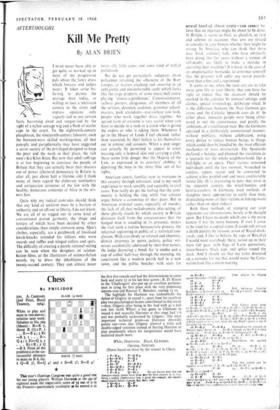Chess
By PHILIDOR 27o. A. CARESMEL (2nd Prize, Brazil Tourney, 1964).
White to play and mate in two moves ; solution next week. Solution to No. 269 (Ahues) : R—K 7, threat R (7)XP. ...B—B4;2Kt
—B 3. I. • . B— Q 4 ; 2 Kt—Q 3. I . . . KtxR; 2 Q
—R 8. Point of the problem is in the un- successful attempts to mate on K 6, viz.
BLACK (4 men) WHITE (7 men)
This year's Hastings Congress was quite a good one for our young players. William Hartston at the age of eighteen made the respectable score of 31 out of 9 in the Premier—particularly creditable as he scored o in Q—R 3?, B—Q 4 ! and B—R 2?, B—B 4! the first five rounds and had the determination to come back and score 31 in his last four games ; R. D. Keene in the 'Challengers' also put up an excellent perform- ance in tying for first place with the very promising sixteen-year-old Russian Y. Balashev, scoring 7410.
The highlight for Hartston was undoubtedly his defeat of Gligoric in round 7 ; apart from his excellent play two psychological factors contributed to this result —first, Gligoric after being in the lead with 41/5 had just lost (with White) a key game to Uhlmann in round 6 and secondly Hartston at this stage had 1 6 and was probably underrated by Gligoric. The most important technical point—as Hartston shrewdly points out—was that Gligoric allowed a risky and double-edged variation instead of forcing Hartston to play positionally where his inexperience would have mattered much more.
White, HARTSTON. Black, GLIGORIC. Opening, SICILIAN.
(Notes based on those by the winner in Chess).
P--x 4 P—Q B 4
Kt—K B 3 P—Q 3
3 P—Q 4 P P 4 Kt x PKt—KB3
5 Kt--Q B 3 P—Q R 3 6 B—K Kt 5 P—K 3
7 P—B 4 Q—Kt 3 No one knows who this line
favours—many germs have been woo by both players in it; but, being a highly combinative line, it gives the younger, less experi- enced player better chances than most lines.
8 Q—Q 2 Q x P
9 R—Q Kt r Q—R 6
ro P—B g
First played by Oipslie
. . .
against Korchnoi (USSR, 1963).
so . . 1■1—B 3 P P z P
,zKtxKr
P Kt
73 P—K 5 P r,
Still following ng Ginnie/ Korchnoi; as Hartston says, 13 . . Kt—Q 4 is better. After text Black's _position is too much broken up.
14 22 'X Kt PCB Kt—K 4 B—K 2 r6 13-1C 2 0-0
17 0-0?. . Here Gipslis game went . 17 R—Kt 3! Q—R 5: t8 P—B 4, K—R 1; 19 0-0, R—R z; 20 Q—R 6, P—K B 4; 21 R—Kt 3, B—Kt 5; 22 Kt—B 6, Resigns. Q—R ? 17 . . B—B 4 ch;
5
K—R t. Q—K 6;19 Q Q. B Q; 2o Kt x ch should be good enough to draw and 17 B—Q 1; tS R—Kt Q—K 2 is best if Black wants to try to win. After the text Black s queen is out of the game for too long.
18 P—B 4! P—K B • Overlooking the strength of White's reply. Better 18 . . R—R 2 though 19 Q—R 6 is then strong (16 . . . P—K B 4; 20 R—Kt 8! threatening R x B). 79 R—Kt 3! P—B 4 19 . P.r Kt ?; 20 R—Kt 3 ch. K—R R x R ch. x R; 22 Q—Kt 5
Overlooking the quicker
30 R2°--Q—Kt 3Rch6,PK—R. t: 2t Q—B 3! R—B z Or 20 . . . P—B 5; 21 Kt—Kt 5, B Kt; 22 Q B ch, K—R 1 (22 . . . K—B 2; 23 B—R 5 mate.; 23 Q• K P ch, K—Kt II; 24 R—Kt 3 chi, P x R; QL—Kt 5 ch and 26 R x R mate.
21 it—Kt 3 ch K—R r 22 B—R 5 Q-1( 23 R it P.!
Very fine indeed and far
. . .
superior to 23 R—Kt 7?, R a 12; 2.4 B a Q, B—Kt 2!
P x R 23 . . B—B 1;24 Q—Kt 5. t 2; 25 Q—B 6! 22 4 Ktx—Q 6! B x Kt
5 nR
Resigns QxB; 26 QxB (threat Q—Q 8 or Q • KP) and now (a) 26 . — Q—K ; 27 Q--13 6 mete (b) 26 . . P—K R 4; 27 Q—R 6 ch, Q—R 2; 28 Q—B 8 ch. One of the best final combinations I have seen for a long time.






























 Previous page
Previous page